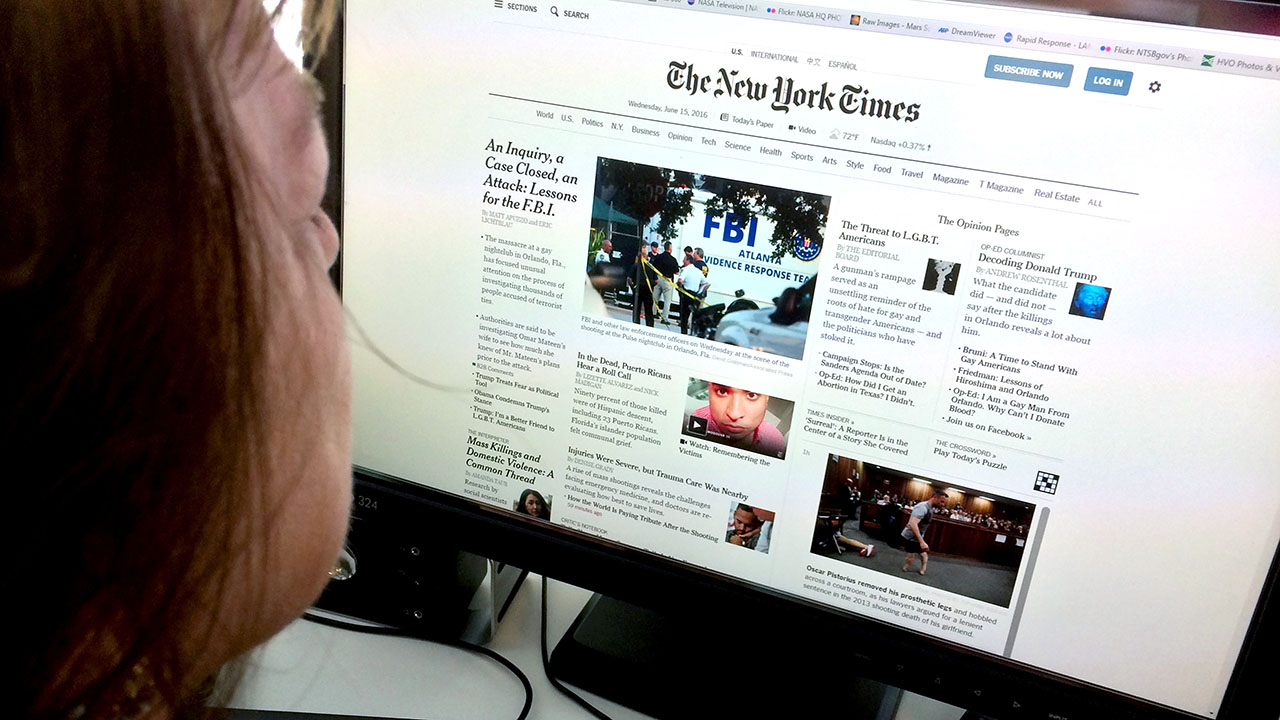The Effect of Social Network on the Method We Take In News Online
Social network has essentially transformed news usage. It supplies instant access to info, frequently overshadowing traditional media electrical outlets. However, this quick dissemination includes challenges. Individuals face the threat of encountering false information and becoming trapped in resemble chambers. The formulas driving individualized content can cover varied point of views. As these characteristics progress, comprehending their ramifications comes to be vital for informed involvement in public discussion. What methods might assist browse this complicated landscape?
The Evolution of News Usage in the Digital Age
As technology progressed, the way people taken in news changed considerably in the electronic age (stnews.live). Conventional papers and broadcast media started to decline as the web arised as a primary resource of info. On-line systems supplied instant accessibility to newspaper article, video clips, and podcasts, permitting customers to remain educated any time. The benefit of smart phones better accelerated this shift, allowing individuals to get updates on the go
Furthermore, the surge of news aggregators and web sites helped with the intake of diverse viewpoints, empowering users to tailor their news consumption based on personal passions. This evolution likewise triggered news companies to adapt their methods, concentrating on digital content and appealing readers through multimedia styles. Consequently, the traditional barriers of time and area in news delivery decreased, leading to an extra prompt and tailored news experience for audiences worldwide.
The Role of Social Network Operatings Systems in News Circulation
Social media site platforms have changed news circulation by offering instant accessibility to info. Their algorithm-driven web content curation frequently prioritizes involvement over accuracy, bring about significant integrity difficulties (stnews.live). As individuals browse this landscape, the implications for news consumption and public discourse ended up being progressively complicated
Immediate News Access
Although traditional news outlets have actually long been the main source of details, the surge of social media sites platforms has actually drastically transformed exactly how news is accessed and eaten. Instantaneous news accessibility has actually ended up being a hallmark of the digital age, allowing customers to get updates in genuine time. Systems such as Twitter, Facebook, and Instagram allow news to spread out rapidly, commonly surpassing conventional media in speed and reach. Users can share stories, discuss occasions, and engage with reporters, developing a dynamic communication between the target market and news material. This immediacy fosters a culture of seriousness, prompting customers to seek details rapidly. The expectation for timely news has improved journalistic practices, compelling news companies to adapt their techniques to fulfill the demands of a hectic electronic environment.
Algorithm-Driven Content
While users actively engage with material on social networks, the algorithms that regulate these platforms play a critical duty in establishing which newspaper article obtain visibility. These algorithms examine customer habits, choices, and engagement metrics to curate individualized news feeds. Because of this, particular stories may be intensified while others remain odd, usually focusing on mind-blowing or trending topics over substantive coverage. This careful exposure forms customers' understandings of existing occasions and affects public discourse. The reliance on algorithm-driven web content can develop resemble chambers, where customers are mostly revealed to point of views that align with their own ideas. The dynamics of news circulation on social media systems significantly affect just how individuals eat and analyze information in the digital age.
Reliability Obstacles
As individuals significantly turn to social media for news, the credibility of details come across on these systems ends up being a pressing worry. The decentralized nature of social media permits anybody to release material, frequently obscuring the lines between trustworthy journalism and misinformation. Formulas prioritize engagement over precision, leading to the prevalent circulation of thrilling or misleading tales. This environment postures substantial difficulties for customers attempting to determine reliable sources. Social media site platforms, while venturing to battle misinformation with fact-checking and web content moderation, run the gauntlet for disparities and predispositions in their strategies. Ultimately, the obligation exists with individuals to critically review the news they consume, as the quick spread of info often exceeds confirmation efforts by systems.
The Surge of Person Journalism and User-Generated Web Content
The rise of resident journalism has actually empowered day-to-day individuals to share news and perspectives, commonly giving insights that conventional media might ignore. Nonetheless, this change additionally offers considerable challenges, especially the spread of false information that can develop from unverified material. As user-generated web content becomes extra common, the balance in between genuine voices and precision in reporting remains a vital issue.
Equipping Daily Voices

Challenges of False information
While the increase of person journalism has opened methods for varied voices in the media landscape, it has likewise presented substantial challenges related to false information. The convenience of sharing details through social networks platforms enables individuals to distribute news promptly, yet this rapid spread commonly comes at the cost of precision. User-generated content often lacks the extensive fact-checking and content oversight that typical journalism provides. Subsequently, sensationalized or false narratives can gain traction, misguiding target markets and shaping public understanding (stnews.live). In addition, the blending of viewpoint and truth within social networks complicates the distinction between trustworthy details and false information. Consequently, consumers should navigate an increasingly complicated media atmosphere, requiring critical assuming skills to discern reliable news resources among the sound

Misinformation and Its Effects for Public Discourse
As social media sites systems increasingly control the landscape of info circulation, the spreading of false information postures considerable difficulties for public discourse. Misinformation, often made to misguide or prompt psychological reactions, can misshape perceptions of reality and weaken rely on credible sources. This sensation leads to polarized perspectives, as people move towards echo chambers that strengthen their ideas, further lodging departments within culture.
The ramifications for public discussion are extensive. When citizens rely on false info, purposeful dialogue reduces, and the democratic process experiences. False information can incite worry and complication, affecting public health, security, and political stability. Therefore, cultivating media literacy comes to be necessary, equipping individuals to critically examine info and recognize fact from fiction. Addressing the challenges positioned by false information is essential for maintaining the stability of public discourse and guaranteeing a knowledgeable population efficient in involving in useful discussions.
The Influence of Algorithms on News Presence
Offered the central role of algorithms in determining content visibility, their influence on news usage is profound. These algorithms, made use of by social networks platforms, focus on particular kinds of content based upon customer interaction and choices. Therefore, newspaper article that align with prominent trends or target market passions are more probable to be shown plainly, while less dig this astonishing stories may be forgotten. This creates a setting where users are subjected largely to info that reinforces their viewpoints, potentially resulting in resemble chambers.
Additionally, the continuous advancement of algorithms means that news organizations must adjust their techniques to line up with these altering parameters, commonly focusing on clickbait or emotionally billed headings. Consequently, the honesty of news coverage can be jeopardized, as essential stories may not get the visibility they should have. The mathematical shaping of news visibility therefore plays a necessary role in affecting public understanding and understanding of present events.
The Shift Towards Visual Storytelling in News Media
Significantly, news media is embracing aesthetic storytelling as a powerful device to engage target markets. This approach leverages images, videos, infographics, and interactive aspects to communicate information much more properly than typical text-based layouts. As attention covers reduce, visuals offer a quick, impactful way to interact complicated tales and grab customers' interest.
Systems like Instagram and TikTok have further accelerated this fad, compelling wire service to adapt their material approaches to fit these visually-driven environments. By including compelling visuals, news outlets can boost psychological links and foster higher understanding of topical problems.
Furthermore, visual narration enables even more diverse stories, showcasing multiple point of views via vibrant discussions. As audiences increasingly eat news with mobile phones, the shift towards visuals not only deals with customer choices yet likewise aids to break down obstacles to info access. Eventually, this development mirrors a more comprehensive transformation in just how news is produced and consumed in the electronic age.
Future Patterns: Browsing the Transforming Landscape of News Consumption
While the electronic landscape proceeds to evolve, news usage is poised for substantial change driven by arising technologies and altering target market behaviors. As fabricated intelligence read the full info here and maker learning breakthrough, personalized news feeds will end up being more prevalent, permitting users to get material customized to their rate of interests. This customization might cause better interaction yet also increase problems regarding resemble chambers and misinformation.
Additionally, the surge of voice-activated devices and smart speakers will certainly affect how news is supplied, moving the focus from visual to acoustic formats. This pattern may motivate wire service to take on even more succinct and appealing audio material.

Often Asked Questions
How Do Social Network Interactions Affect News Integrity?
Social media site communications can significantly influence perceptions of news trustworthiness. Interaction metrics, such as sort and shares, usually form target market count on, with prominent messages acquiring perceived authenticity, despite the accuracy or reliability of the details provided.
What Role Do Influencers Play in Shaping News Narratives?
Influencers substantially shape news stories by leveraging their platforms to enhance More Info particular stories, usually customizing material to their audience. This can lead to biased point of views, affecting public assumption and prioritizing sensationalism over factual reporting.
Exactly How Can Users Identify Reliable News Resources on Social Media Site?
Users can identify reputable news resources on social networks by examining the source's credibility, verifying facts via numerous electrical outlets, reviewing the professionalism and reliability of the material, and recognizing potential predispositions in reporting to guarantee accurate details.
What Influence Does Social Network Have on Conventional Journalism Jobs?
Social media site substantially influences traditional journalism tasks by modifying profits designs, decreasing need for print media, and promoting competitors from citizen journalists. Lots of specialists face work instability and should adjust to quickly transforming media landscapes.
Just How Do Various Demographics Consume News on Social Media?
Various demographics show varied preferences for news usage on social media. More youthful audiences prefer platforms like TikTok and Instagram for fast updates, while older individuals have a tendency to like Facebook and Twitter for extra thorough conversations and articles.